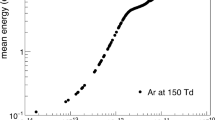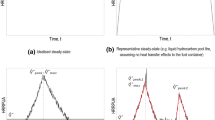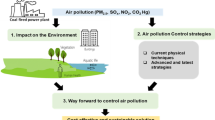Abstract
Annular pool fires, frequently happened in chemical industries, have a significant influence on environmental pollution. Air pollution, greenhouse gas emissions, water pollution, and soil contamination are general ways of environmental hazards caused by the annular pool fires. This study built upon our previous study (Environ. Sci. Pollut. Res., 2023, 30(21): 59781–59792.), and extended to investigate the combustion and fire plume flow behaviors of annular pool fires, both with and without air entrainment through the hollow center of the annular pool. Results show that when there is no air entrainment through the hollow center, the low combustion intensity area at the plume’s central axis gradually extends while the high combustion intensity area concentrates at higher places and the flame height increased by nearly 40% from a solid pool (Din/Dout = 0) to the annular pool (Din/Dout = 0.80). Additionally, the area with high combustion intensity is more concentrated at a higher position. The combustion of annular pool fires was found to be dominated by non-premixed diffusion combustion. The center of the annular pool fires is dominated by air prior to flame merging and by fuel vapor after the merging occurs. For annular pool fires with air entrainment through the center of the pool, the combustion intensity increases as Din/Dout at the plume base increases. And, the flame height decreased by nearly 25% as Din/Dout increases. Flame burning occurs both on the outside and inside of the plume, exhibiting a “double layer” combustion characteristic. It reveals that the combustion of the fire plume transitions to premixed diffusion combustion. The center of the annular pool fire is predominantly composed of air. Understanding and controlling annular pool fires can lead to new methods for remediating fuel spills, reducing pollution from combustion, and advancing research in fluid mechanics.












Similar content being viewed by others
Data availability
The data and materials used and analyzed during the current study are available from the corresponding author on reasonable request.
Abbreviations
- cp:
-
Specific heat (kJ·kg−1 K−1)
- C:
-
Constant
- D*:
-
Fire diameter (m)
- Din:
-
Inner pool diameters (m)
- D out :
-
Outer pool diameters (m)
- g :
-
Gravitational acceleration (m·s−2)
- k :
-
Empirical coefficients
- \({\dot{m}}_{\alpha }\) :
-
The integrated volume of plume entrained air
- Q :
-
Heat release rate (kW)
- S :
-
Pool area (m2)
- ΔT :
-
Temperature difference between the flame and the ambient (K)
- \({T}_{\infty }\) :
-
Ambient temperature (K)
- u :
-
The normal component of the velocity of the flow field
- \({\rho }_{\infty }\) :
-
Air density (kg/m3)
References
Akita K, Yumoto T (1965) Heat transfer in small pools and rates of burning of liquid methanol. Symposium (International) on Combustion 10:943–948. https://doi.org/10.1016/S0082-0784(65)80237-5
Bi Y, Yang Z, Cong H, Bi M, Gao W (2022) Experimental and theoretical investigation on the effect of inclined surface on pool fire behavior. Process Saf Environ Prot 162:328–336. https://doi.org/10.1016/j.psep.2022.03.084
Bi Y, Yang Z, Cong H, Ye L, Bi M (2023) An experimental study and mathematical quantification of buoyant turbulent flame morphology under the coupling effects of inclined surfaces and crossflows. Fuel 332:126079. https://doi.org/10.1016/j.fuel.2022.126079
Bi Y, Yang Z, Wang J, Huang S, Cong H, Ye L, Bi M (2024) General models of buoyant sidewall flame morphology affected by crossflows on the inclined surface based on the mirror approach. Fuel 357. https://doi.org/10.1016/j.fuel.2023.129763
Deng L, Tang F, Ma X (2021) Experimental study on flame merging probability and pulsation frequency of annular hydrocarbon pool fires with various inner and outer diameters. Process Saf Environ Prot 146:473–480. https://doi.org/10.1016/j.psep.2020.11.015
Dou Y, Liu H, Liu B, Zhang Y, Liu Y, Cheng X, Tao C (2021) Effects of carbon dioxide addition to fuel on flame radiation fraction in propane diffusion flames. Energy 218:119552. https://doi.org/10.1016/j.energy.2020.119552
Fan CG, Ji J, Wang W, Sun JH (2014) Effects of vertical shaft arrangement on natural ventilation performance during tunnel fires. Int J Heat Mass Transf 73:158–169. https://doi.org/10.1016/j.ijheatmasstransfer.2014.02.003
Gao Z, Li L, Zhong W, Liu X (2021) Characterization and prediction of ceiling temperature propagation of thermal plume in confined environment of common services tunnel. Tunn Undergr Space Technol 110:103714. https://doi.org/10.1016/j.tust.2020.103714
Gao Y, Lu Z, Hua Y, Liu Y, Tao C, Gao W (2022a) Experimental study on the flame radiation fraction of hydrogen and propane gas mixture. Fuel 329:125443. https://doi.org/10.1016/j.fuel.2022.125443
Gao Z, Li L, Sun C, Zhong W, Yan C (2022b) Effect of longitudinal slope on the smoke propagation and ceiling temperature characterization in sloping tunnel fires under natural ventilation. Tunn Undergr Space Technol 123:104396. https://doi.org/10.1016/j.tust.2022.104396
Hamins A, Fischer SJ, Kashiwagi T, Klassen ME, Gore JP (1994) Heat feedback to the fuel surface in pool fires. Combust Sci Technol 97:37–62. https://doi.org/10.1080/00102209408935367
Huang P, Zhang R, Yu L, Liu C (2023b) Study on the combustion, entrainment, and plume flow behaviors of annular pool fires. Environ Sci Pollut Res 30:59781–59792. https://doi.org/10.1007/s11356-023-26748-1
Huang P, Liu S, Liu C, Yang F, Zhang B, Yu L (2023) Flame extension lengths beneath a double slope roof induced by gaseous fuel jet flame. Fuel 350. https://doi.org/10.1016/j.fuel.2023.128891
Huang P, Zhang R, Liu C, Wu X, Chen S, Li J, Li M, Yu L (2024) Experimental study on the mass burning rate and flame tilt angle of annular pool fires under cross air flow. Fuel 357. https://doi.org/10.1016/j.fuel.2023.129985
Jangi M, Dlugogorski BZ (2017) On wall fire interaction in a small pool fire: a large-eddy simulation study. Fire Saf J 92:199–209. https://doi.org/10.1016/j.firesaf.2017.03.056
Jangi M, Altarawneh M, Dlugogorski BZ (2016) Large-eddy simulation of methanol pool fires using an accelerated stochastic fields method. Combust Flame 173:89–98. https://doi.org/10.1016/j.combustflame.2016.08.017
Ji J, Guo F, Gao Z, Zhu J, Sun J (2017) Numerical investigation on the effect of ambient pressure on smoke movement and temperature distribution in tunnel fires. Appl Therm Eng 118:663–669. https://doi.org/10.1016/j.applthermaleng.2017.03.026
Li C, Ma X, Yang R, Zhang H (2021) Characterization of n-heptane annular pool fires based on flame shape and texture features. J Tsinghua Univ (science and Technology) 61(6):502–508
Li M, Ji S, Zhang C, Wang C (2023a) Ignition and vapor transfer behavior of liquid fuel ignited by radiation from neighbouring liquid pool fire. Int Commun Heat Mass Transfer 142:106634. https://doi.org/10.1016/j.icheatmasstransfer.2023.106634
Li J, Pu J, Ren K (2015) Effects of plume heat feedback in heptane pool fires : insight from theory and simulation. 2015 4th National Conference on Electrical, Electronics and Computer Engineering 905–909. https://doi.org/10.2991/nceece-15.2016.164
Li M, Xu Z, Luo Q, Wang C (2023) Investigation of bicubic flame radiation model of continuously opposed spilling fire over n-butanol fuel. Energy 272. https://doi.org/10.1016/j.energy.2023.127144
Liu C, Ding L, Ji J (2021b) Experimental study of the effects of ullage height on fire plume centerline temperature with a new virtual origin model. Process Saf Environ Prot 146:961–967. https://doi.org/10.1016/j.psep.2020.12.025
Liu C, Ding L, Jangi M, Ji J, Yu L (2021) Effects of ullage height on heat feedback and combustion emission mechanisms of heptane pool fires. Fire Saf J 124. https://doi.org/10.1016/j.firesaf.2021.103401
Liu C, Lai T, Zhang H, Huang P, Lin K, Lin Y, Li M (2024) Experimental study on the morphology of turbulent diffusion flames with different aspect ratios under slope conditions. Fuel 357. https://doi.org/10.1016/j.fuel.2023.129827
Lu Z, Gao Y, Li G, Liu B, Xu Y, Tao C, Meng S, Qian Y (2022) The analysis of temperature and air entrainment rate for the turbulence diffusion jet flame of propane and carbon dioxide gas mixture. Energy 254:124232. https://doi.org/10.2139/ssrn.4014179
McGrattan KB, Baum HR, Rehm RG, Hamins A, Forney GP, Floyd JE, Hostikka S, Prasad K (2000) Fire dynamics simulator–technical reference guide. National Institute ofStandards and Technology, Building and Fire Research Laboratory, Gaithersburg
McGrattan KB, Forney GP (2013) Fire dynamics simulator user’s guide. NIST special publication. 1019:1–339. https://doi.org/10.6028/nist.Sp.1019
Persson H, Lönnermark A (2004) Tank fires: review of fire incidents. Stockholm: Swedish National Testing and Research Instiute
Sun H, Wang C, Liu H, Li M, Zhang A, Zhao W, Gao C (2017) Experimental study of combustion characteristics of circular ring thin-layer pool fire. Energy Fuels 31:10082–10092. https://doi.org/10.1021/acs.energyfuels.7b01504
Tan T, Yu L, Ding L, Gao Z, Ji J (2021) Numerical investigation on the effect of ambient pressure on mechanical smoke extraction efficiency in tunnel fires. Fire Saf J 120. https://doi.org/10.1016/j.firesaf.2020.103136
Tao C, Liu Y, Tang F, Wang Q (2018) An experimental investigation of the flame height and air entrainment of ring pool fire. Fuel 216:734–737. https://doi.org/10.1016/j.fuel.2017.11.141
Wang C, Guo J, Ding Y, Wen J, Lu S (2015) Burning rate of merged pool fire on the hollow square tray. J Hazard Mater 290:78–86. https://doi.org/10.1016/j.jhazmat.2015.02.069
Wang Q, Tang F, Liu H, Zhou Z, Palacios A (2018a) Experimental Investigation on the effect of a reduced pressure on the combustion characteristics and flame height of gaseous fuel jets in parallel sidewalls. Energy Fuels 32:2490–2496. https://doi.org/10.1021/acs.energyfuels.7b03871
Wang Y, Liu M, Liu F, Zhao C, Zhao D, Han F, Liu C (2018b) Research on the effect of wall corrosion and rim seal on the withdrawal loss for a floating roof tank. Environ Sci Pollut Res 25:18434–18442. https://doi.org/10.1007/s11356-018-1978-2
Wang Q, Hu L. Tang F, Palacios A, Chung SH (2023) An experimental study and analysis of lift-off length in inclined nonpremixed turbulent jet flames. Combust Flame 255. https://doi.org/10.1016/j.combustflame.2023.112855
Yao Y, He K, Peng M, Shi L, Cheng X (2021a) The maximum gas temperature rises beneath the ceiling in a longitudinal ventilated tunnel fire. Tunn Undergr Space Technol 108. https://doi.org/10.1016/j.tust.2020.103672
Yao Y, Li YZ, Ingason H, Cheng X, Zhang H (2021b) Theoretical and numerical study on influence of wind on mass loss rates of heptane pool fires at different scales. Fire Saf J 120. https://doi.org/10.1016/j.firesaf.2020.103048
Yao Y, Wang R, Xia Z, Shi C, Ren F (2023a) Smoke movement and control in longitudinal ventilated tunnel fires with cross-passages. Case Stud Therm Eng 45. https://doi.org/10.1016/j.csite.2023.102945
Yao Y, Zhang Y, Zhu H, Han Z, Zhang S, Zhang X (2023b) Effects of ambient pressure on characteristics of smoke movement in tunnel fires. Tunn Undergr Space Technol 134. https://doi.org/10.1016/j.tust.2023.104981
Zhang X, Tao H, Xu W, Liu X, Li X, Zhang X, Hu L (2017) Flame extension lengths beneath an inclined ceiling induced by rectangular-source fires. Combust Flame 176:349–357. https://doi.org/10.1016/j.combustflame.2016.11.004
Zhang Y, Li Y, Zhu J, Yang Y (2019) Reasearch on axial temperature distribution of annular pool fires of floating roof tanks. China Saf Sci J 29:61–66
Zhang X, Zhang Z, Zhang Z, Xu W, Luo Q, Tao H, Li X (2020) Experimental investigation of compartment fires with circular opening: from the aspects of internal temperature and facade flame. Combust Flame 213:107–116. https://doi.org/10.1016/j.combustflame.2019.11.027
Zhang S, Zhao J, Zhang Q, Zhang J, Jiang H (2023) Experimental study and numerical analysis of thermal hazard for fire accident in converter transformers. Therm Sci Eng Prog 45. https://doi.org/10.1016/j.tsep.2023.102108
Zhao J, Song G, Zhang Q, Li X, Huang H, Zhang J (2023) Experimental study on flame length and pulsation behavior of n-heptane continuous spill fires on water. J Loss Prev Process Ind 85. https://doi.org/10.1016/j.jlp.2023.105174
Zhong W, Sun C, Bian H, Gao Z, Zhao J (2021) The plug-holing of lateral mechanical exhaust in subway station: phenomena, analysis, and numerical verification. Tunn Undergr Space Technol 112:103914. https://doi.org/10.1016/j.tust.2021.103914
Funding
This work was supported by the Opening Funds of State Key Laboratory of Building Safety and Built Environment & National Engineering Research Center of Building Technology (BSBE2021–05), the Youth Innovation Project of Natural Science Foundation of Fujian Province (2022J05123, 2023J05104), National Natural Science Foundation of China (52211530486, 52006210), and the Opening Fund of State Key Laboratory of Fire Science (HZ2022-KF05).
Author information
Authors and Affiliations
Contributions
All authors contributed to the study conception and design. Ping Huang: Original draft, Methodology. Rui Zhang: Data curation, Formal analysis. Longxing Yu: Reviewing and Methodology. Chunxiang Liu: Funding acquisition and Supervision. Xinyue Wu, Dimin Chen, and Shanshan Chen: investigation and data processing. All authors commented on previous versions of the manuscript. All authors read and approved the final manuscript.
Corresponding author
Ethics declarations
Ethical approval
Research does not report on or involve the use of any animal or human data or tissue.
Consent to participate
Not applicable.
Consent for publication
All the authors gave consent for the publication of this journal.
Competing interests
The authors declare no competing interests.
Additional information
Responsible Editor: Philippe Garrigues
Publisher's Note
Springer Nature remains neutral with regard to jurisdictional claims in published maps and institutional affiliations.
Rights and permissions
Springer Nature or its licensor (e.g. a society or other partner) holds exclusive rights to this article under a publishing agreement with the author(s) or other rightsholder(s); author self-archiving of the accepted manuscript version of this article is solely governed by the terms of such publishing agreement and applicable law.
About this article
Cite this article
Huang, P., Zhang, R., Liu, C. et al. Burning and plume flow behaviors of annular pool fires: with and without air entrainment through the pool center. Environ Sci Pollut Res 31, 8012–8025 (2024). https://doi.org/10.1007/s11356-023-31385-9
Received:
Accepted:
Published:
Issue Date:
DOI: https://doi.org/10.1007/s11356-023-31385-9




